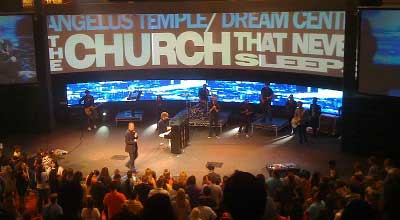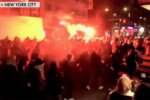Angelus Temple, founded in 1923 by Aimee Semple McPherson, lost its edge in recent years. But today the historic landmark is poised to reach a new generation for Christ.
You know you’re in Dream Center territory when on inner-city street corners you see groups of tough-looking men with push brooms and wheelbarrows beautifying their neighborhoods. It’s Sunday morning in Echo Park–the rough part of Los Angeles depicted and captured visually in the recent Oscar-winning film Training Day. But for now the bad guys are quiet, and hundreds of people–Bibles in hand, kids in tow–stream toward the grand, domed church at the park’s edge. Others arrive aboard the converted Greyhound buses plying the streets–buses now emblazoned with the BADD logo for “Born Again Delivered Disciples.”
A huge sign welcomes people to a “brand-new day in the beautifully renovated sanctuary,” and the inside bears this out. Ikea-style chandeliers and new carpet give the lobby flair. There’s a café and bookstore, and greeters are at every door. But the dazzling stuff is in the sanctuary with its two balconies, bright-red carpet, new theater seats, klieg lights, arena-style stage assembly and newly added air conditioning, all items that make this 80-year-old meeting place hospitable to the modern churchgoer.
Amazingly, the new touches, which cost $7 million, seem to elevate the cherished architectural features that make Angelus Temple a designated national- historic landmark: its eight stained-glass windows two stories tall; its blue, domed ceiling, now hung tastefully with sound baffles; the two balconies; and its mural of Jesus.
But what could have become merely a religious landmark is now the scene of remarkable revival, thanks to significant recent changes.
Today seats are filling up. Kneeling people pray on the steps of the platform. As 10 a.m. approaches, the buzz of anticipation grows louder, and the silky white scrim pulls aside to reveal a platform filled with musicians including 10 singers, a trumpeter and a guy scratching records at a built-in turntable. Behind them is a huge arcing video screen where images flash at rapid speed.
“Lift your praises up to the Lord!” the worship leader and crew sing, pumping their fists in the air. The 2,200 or so people in the theater follow suit, clapping, hopping and shouting. It’s a high-volume experience.
After the aerobic worship time, the pastor, a young blond man in a suit, takes the stage to say how much he’s anticipated giving this morning’s sermon. He prays, invites the band to crank through the last song again, and then the scrim draws closed, and he is alone with the audience.
The young man is Matthew Barnett, the 28-year-old visionary whose stewardship of the Dream Center just six blocks away so impressed leaders of the International Church of the Foursquare Gospel (ICFG) that they nominated him for the task of breathing new life into Angelus Temple, their founding church.
He now leads the Dream Center–one of the largest and most innovative churches in the Assemblies of God–and Angelus Temple, the most historically significant Foursquare church. This could be a turning point for the Temple, which went through a rough patch in recent years, and for Barnett, who is emerging as one of the most watched and emulated pastors in America.
On the platform at the Temple, Barnett welcomes visitors from Idaho, Wisconsin, Florida, Michigan and Kentucky. Then he welcomes a distinguished guest, Nathaniel M. Van Cleave, former ICFG general supervisor, and asks him to greet the people.
“I heard so much about what was happening here, and I couldn’t wait to see it with my own eyes,” Van Cleave says, tears in his eyes. “I’ve seen it, I’ve felt it, and I praise God for what’s being done.”
The place erupts with applause, and Barnett hugs him before moving into his sermon.
Angelus Temple–the original megachurch–has operated continuously since it opened January 1, 1923, but it had faltered in recent years. A Hispanic congregation of 1,000 met in an adjacent auditorium on the property, but the main congregation dwindled and stopped meeting in the sanctuary altogether.
That was a far cry from the Temple’s personality in its heyday of the 1920s and throughout the Depression era when Aimee Semple McPherson was one of the most famous people in America. Her theater-style sermons (sometimes illustrated with live animals), daily radio program, healing ministry and the controversy she stirred put the Temple at the epicenter of a strange, wonderful world that had at its core the declaration of the gospel.
McPherson was unlike any evangelist the world had seen, combining the power of the Holy Spirit–in prophecy, the laying on of hands and speaking in other tongues–with Hollywood showmanship. Her life and occasional scandals made front-page news in the country’s major newspapers. And although she died in 1944 she remains one of the most important architects of the modern Pentecostal movement.
The church she built followed the trajectory of her popularity. The opening of Angelus Temple in 1923 drew a crowd of thousands, many arriving before sunrise, clogging the streets and trolley lines. Actor Charlie Chaplin later helped design part of the Temple’s sanctuary.
The church quickly became a magnet, drawing curiosity seekers from around the world, people desperate for healing or hope, the hungry, the poor and the high-class. But what set it apart was that McPherson didn’t just preach the gospel (to vast audiences by radio and in person), she demonstrated it.
She persuaded a dozen doctors and hundreds of nurses to give free services to children and the elderly. The Temple’s commissary evolved into what one biographer called “the greatest welfare agency in [Los Angeles] during the Depression, providing food, clothing and rent money for the needy, regardless of race or religion.” The church fed perhaps millions in that era.
The church also became the cornerstone of a new denomination, the ICFG, which today counts 3.6 million attendees in 123 countries and whose headquarters is a block away from the Temple.
And now the legacy of that founding church comes to rest on Barnett, who was born and raised in the Assemblies of God (AG) but whose ministry style was modeled after McPherson’s. (Barnett is now an officially ordained minister with the Foursquare Church.)







Leave a Comment
You must be logged in to post a comment.